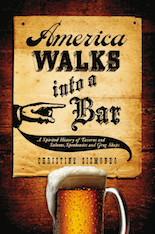
Oxford University Press
hardcover, $24.95, 314 pp.
The evolution of the American bar has been analogous to the evolution of American civic life. Both started as primarily the domain of straight, white, Protestant males of means and British descent; and then both gradually—and grudgingly—expanded to include anybody who wanted in. That is the deliciously clever undercurrent of Ryerson University English professor Christine Sismondo’s America Walks Into a Bar. She does pour out the factoids, enough to power any trivia night, but the narrative is one of expanding access and the empowerment that comes with it.
The Revolutionary generation sanctified the American bar. It was a gathering place to discuss, debate and often agitate, an essential part of the country’s early infrastructure (for reasons of public health as much as much as anything, given the 18th century’s iffy water quality). Philadelphia’s City Tavern, for one, was “the unofficial location of the Continental Congress. George Washington made the City his first stop upon arrival in Philadelphia, having heard so much about it, while John Adams, who might not have been so inclined himself, was ‘whisked off’ to the tavern in the early going. It was there that Washington and Adams met for the first time.”
By the 1830s, the founders were gone, and the country was becoming more diverse. Irish and German immigrants, in particular, were bringing with them their own habits—including those surrounding drinking. The Irish were boisterous in their consumption, “ambibulous,” according to Sismondo; while the Germans mostly drank, in family-friendly beer gardens, the lager they had introduced to the U.S. Regardless, these people had to be shown—forced—to drink as responsibly as the Anglo-Americans supposedly (but not really) did a few generations before. The hypocrisy was entrenched in how the powerful regarded bar owners and tenders. “Those who catered to the immigrant and indigent were increasingly derided; those who served the elites were pronounced artists.”
Restrictions became so pronounced—they had, in fact, already been in place for decades for Native Americans and African-Americans, most of them enslaved—that we’re still dealing with the fever pitch Sismondo leads us toward: Prohibition in 1920. Ironically, Prohibition only pumped more diversity into the national bar scene. Speak-easies sprung up under female supervision, for one thing; and Americans collectively seemed to realize what they were missing, though, despite an enduring perception, alcohol consumption actually dropped during the dry years.
Coming out of them in 1933, a century after last call for the last of the founders, a renaissance flowered. Within two generations, there was a bar for anybody, in virtually every area of the country (except in the Deep South, which is almost entirely absent from Sismondo’s tale of equalitarian evolution): gay, straight, disco, punk, black, white, faux Irish, genuine Irish, craft beer, dive, wine, singles, swingers. So many opened that the American bar, once a refuge for a privileged few, has become as ubiquitous as opinions on the Constitution.



